# Getting started with Auto DevOps
> 原文:[https://docs.gitlab.com/ee/topics/autodevops/quick_start_guide.html](https://docs.gitlab.com/ee/topics/autodevops/quick_start_guide.html)
* [Configure your Google account](#configure-your-google-account)
* [Create a new project from a template](#create-a-new-project-from-a-template)
* [Create a Kubernetes cluster from within GitLab](#create-a-kubernetes-cluster-from-within-gitlab)
* [Install Ingress and Prometheus](#install-ingress-and-prometheus)
* [Enable Auto DevOps (optional)](#enable-auto-devops-optional)
* [Deploy the application](#deploy-the-application)
* [Monitor your project](#monitor-your-project)
* [Work with branches](#work-with-branches)
* [Conclusion](#conclusion)
# Getting started with Auto DevOps[](#getting-started-with-auto-devops "Permalink")
本分步指南將幫助您使用[Auto DevOps](index.html)將 GitLab.com 上托管的項目部署到 Google Kubernetes Engine.
您將使用 GitLab 的本地 Kubernetes 集成,因此您無需使用 Google Cloud Platform 控制臺手動創建 Kubernetes 集群. 您將創建并部署一個從 GitLab 模板創建的簡單應用程序.
這些說明也適用于自我管理的 GitLab 實例; 您只需要確保[配置了](../../ci/runners/README.html)自己的[Runners](../../ci/runners/README.html)并[啟用了 Google OAuth](../../integration/google.html) .
## Configure your Google account[](#configure-your-google-account "Permalink")
在創建 Kubernetes 集群并將其連接到 GitLab 項目之前,您需要一個[Google Cloud Platform 帳戶](https://console.cloud.google.com) . 使用現有的 Google 帳戶登錄,例如用于訪問 Gmail 或 Google 云端硬盤的帳戶,或創建一個新帳戶.
1. 請按照 Kubernetes Engine 文檔的["開始之前"一節](https://cloud.google.com/kubernetes-engine/docs/quickstart#before-you-begin)中描述的步驟來啟用所需的 API 和相關服務.
2. 確保您已使用 Google Cloud Platform 創建了一個[結算帳戶](https://cloud.google.com/billing/docs/how-to/manage-billing-account) .
**提示:**每個新的 Google Cloud Platform(GCP)帳戶都會獲得[$ 300 的信用額](https://console.cloud.google.com/freetrial) ,并且與 Google 合作,GitLab 能夠為新的 GCP 帳戶提供額外的$ 200,以開始使用 GitLab 的 Google Kubernetes Engine Integration. [點擊此鏈接](https://cloud.google.com/partners/partnercredit/?pcn_code=0014M00001h35gDQAQ#contact-form)并申請信用.
## Create a new project from a template[](#create-a-new-project-from-a-template "Permalink")
我們將使用 GitLab 的項目模板之一來開始. 顧名思義,這些項目提供了基于某些知名框架的準系統應用程序.
1. 在 GitLab 中,單擊加號( ),然后選擇**新建項目** .
2. 轉到**從模板創建**選項卡,您可以在其中選擇 Ruby on Rails,Spring 或 NodeJS Express 項目. 對于本教程,請使用 Ruby on Rails 模板.
[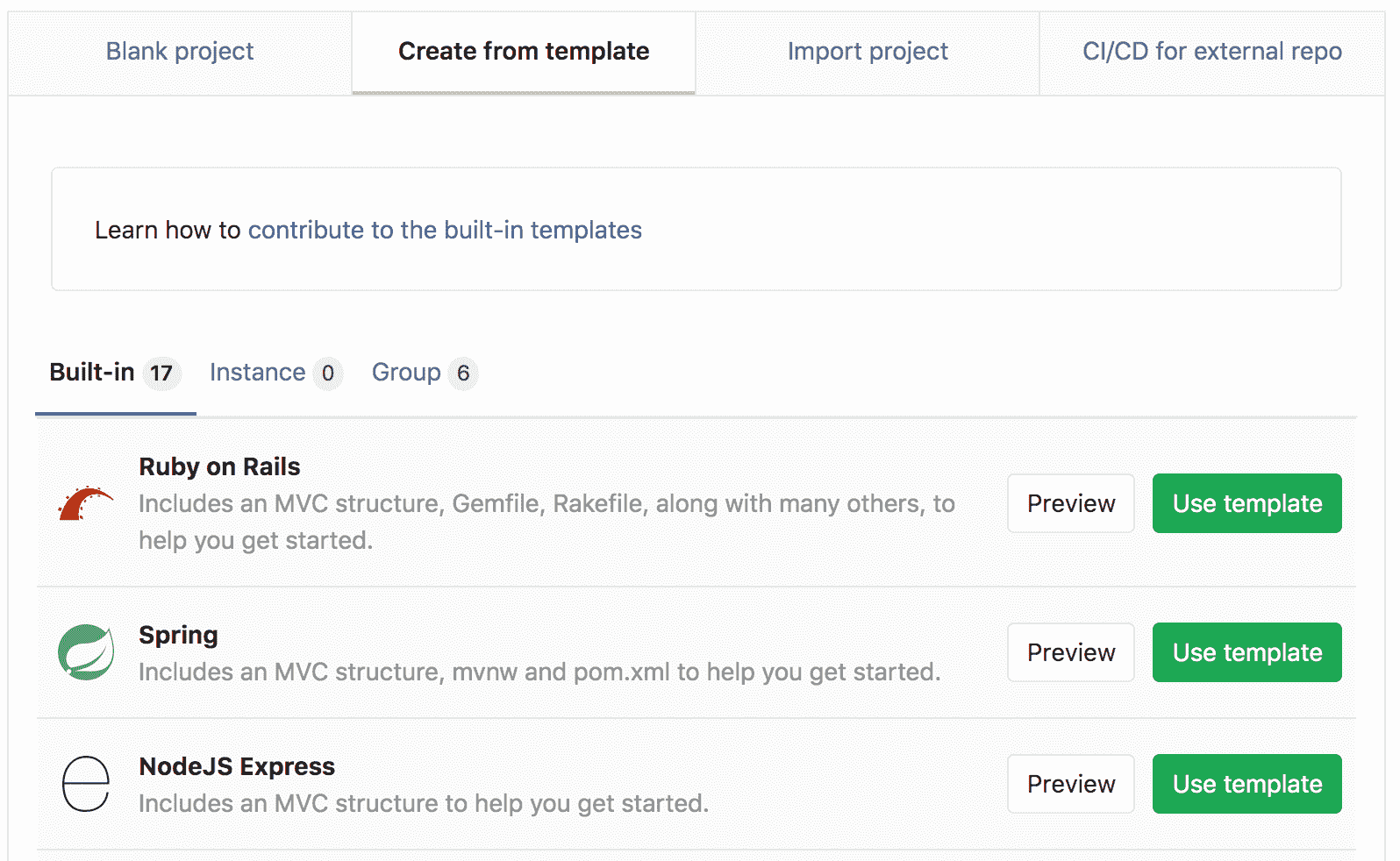](img/guide_project_template_v12_3.png)
3. 給您的項目起一個名字,或者選擇一個描述,并將其公開,以便您可以利用[GitLab Gold 計劃](https://about.gitlab.com/pricing/#gitlab-com)中的可用功能.
[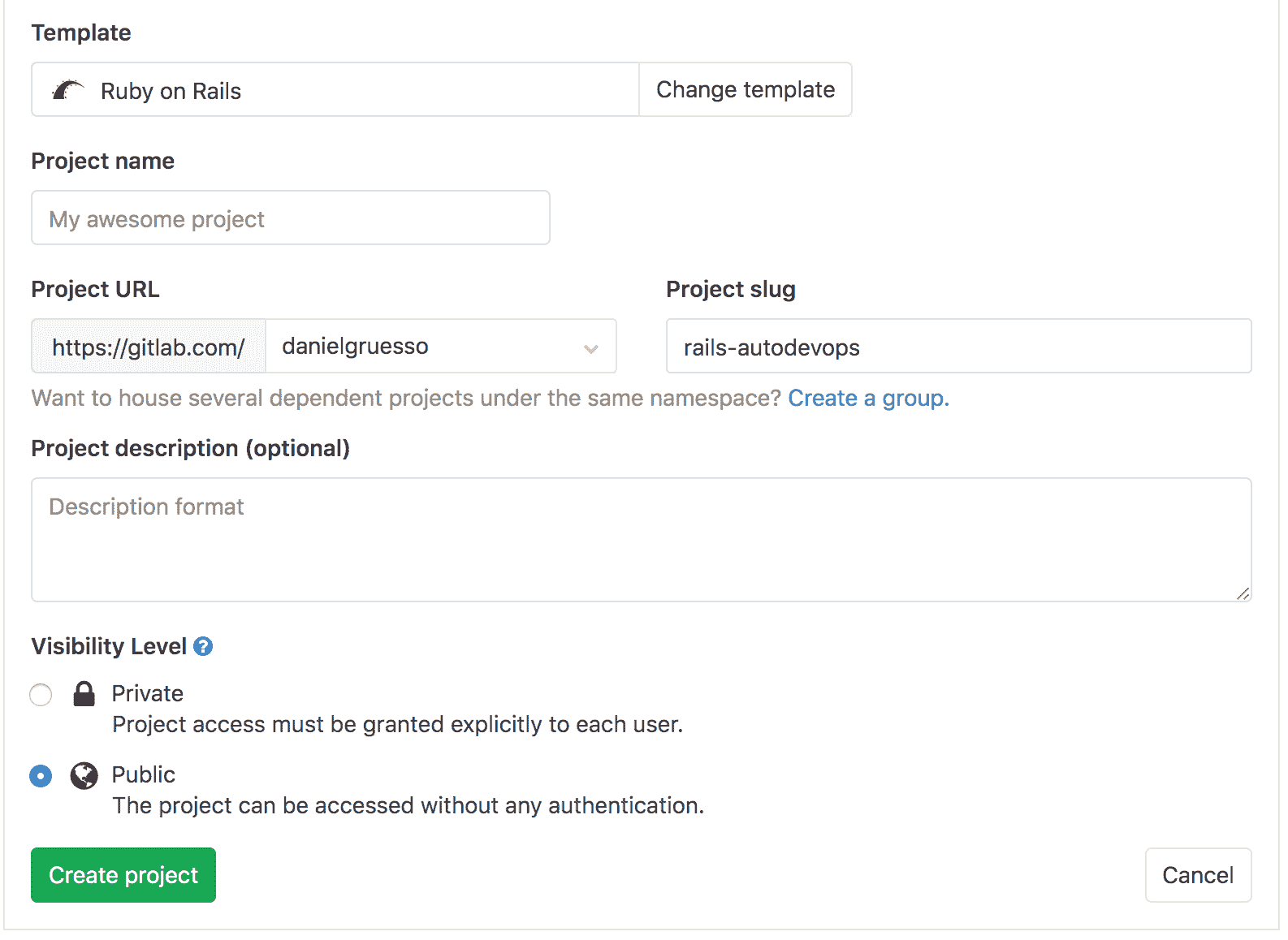](img/guide_create_project_v12_3.png)
4. Click **建立專案**.
現在,您已經創建了一個項目,接下來將創建 Kubernetes 集群以將該項目部署到該集群.
## Create a Kubernetes cluster from within GitLab[](#create-a-kubernetes-cluster-from-within-gitlab "Permalink")
1. 在項目的登錄頁面上,單擊**添加 Kubernetes 集群** (請注意,當您導航到 **操作> Kubernetes** ).
[](img/guide_project_landing_page_v12_10.png)
2. 在" **添加 Kubernetes 集群集成"**頁面上,單擊" **創建新集群"**選項卡,然后單擊" **Google GKE"** .
3. 與您的 Google 帳戶關聯,然后單擊" **允許"**以允許訪問您的 Google 帳戶. (此授權請求僅在您第一次將 GitLab 與您的 Google 帳戶連接時顯示.)
授權訪問后,將顯示" **添加 Kubernetes 集群集成"**頁面.
4. 在**輸入 Kubernetes 集群的詳細信息**部分中,提供有關集群的詳細信息:
* **Kubernetes cluster name**
* **環境范圍** -保留此字段不變.
* **Google Cloud Platform 項目** -選擇一個項目. 在[配置 Google 帳戶后](#configure-your-google-account) ,應該已經為您創建了一個項目.
* **區域** -要在其中創建群集的[區域/區域](https://cloud.google.com/compute/docs/regions-zones/) .
* **節點數**
* **機器類型** -有關[機器類型的](https://cloud.google.com/compute/docs/machine-types)更多信息,請參閱 Google 文檔.
* **為 Anthos 啟用 Cloud Run-**選中此復選框以對該集群使用[Cloud Run](../../user/project/clusters/add_gke_clusters.html#cloud-run-for-anthos) ,Istio 和 HTTP Load Balancing 加載項.
* **由 GitLab 管理的群集** -選中此復選框以[允許 GitLab 管理](../../user/project/clusters/index.html#gitlab-managed-clusters)該群集的[名稱空間和服務帳戶](../../user/project/clusters/index.html#gitlab-managed-clusters) .
5. Click **創建一個 Kubernetes 集群**.
幾分鐘后,將創建集群. 您還可以在[GCP 儀表板上](https://console.cloud.google.com/kubernetes)查看其狀態.
接下來,您將在群集上安裝一些需要充分利用 Auto DevOps 的應用程序.
## Install Ingress and Prometheus[](#install-ingress-and-prometheus "Permalink")
集群運行后,您可以安裝第一個應用程序. 在本指南中,我們將安裝 Ingress 和 Prometheus:
* 入口-在后臺使用 NGINX 提供負載平衡,SSL 終止和基于名稱的虛擬主機.
* Prometheus-一種用于監視已部署應用程序的開源監視和警報系統.
**注意:**我們不會在此快速入門指南中安裝 GitLab Runner,因為該指南使用了 GitLab.com 提供的共享 Runners.
要安裝應用程序:
* 單擊**Ingress**的**安裝**按鈕.
* 顯示**入口端點時** ,復制 IP 地址.
* 添加您的**基本域** . 對于本指南,我們將使用 GitLab 建議的域.
* Click **保存更改**.
[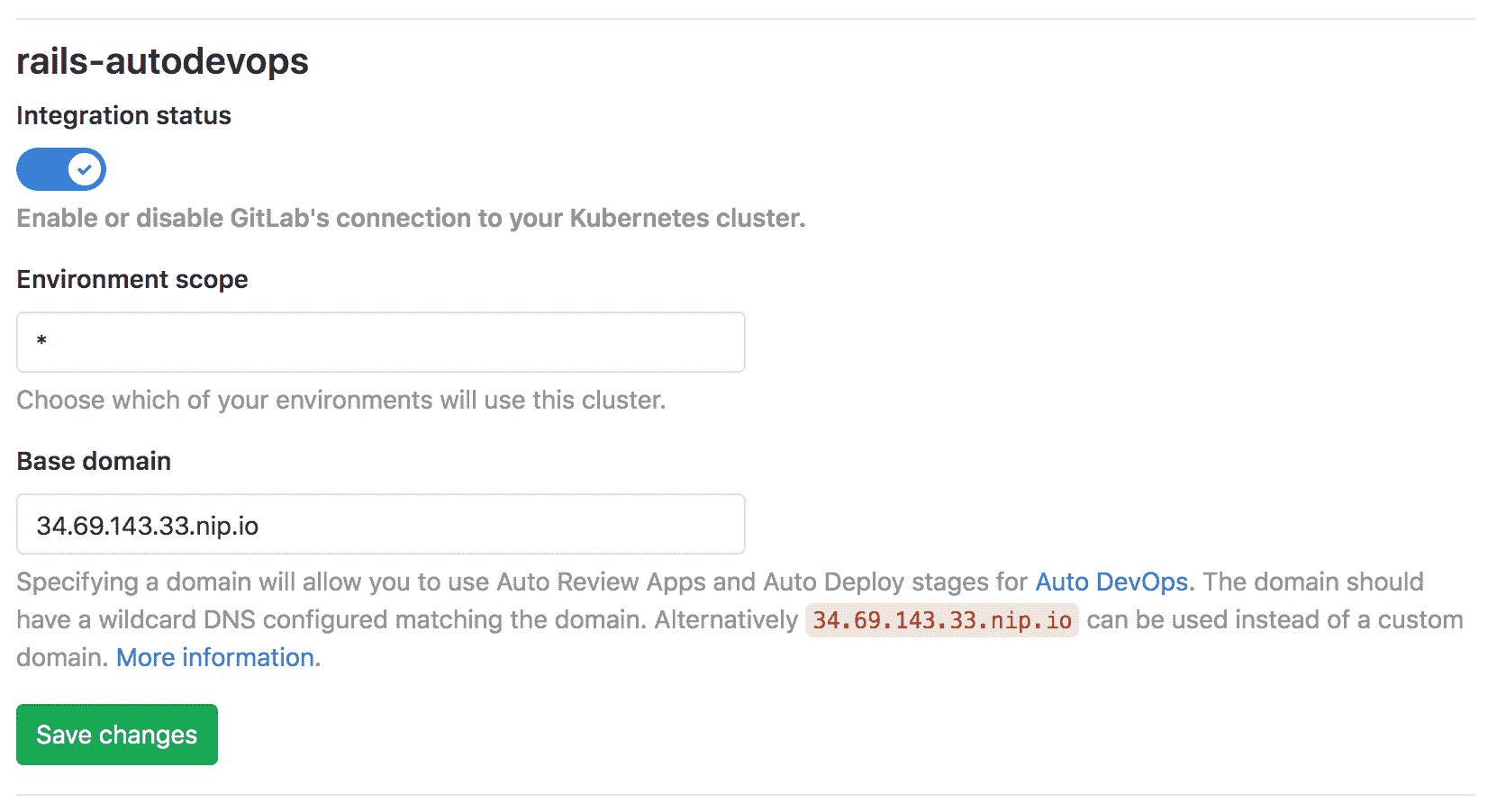](img/guide_base_domain_v12_3.png)
## Enable Auto DevOps (optional)[](#enable-auto-devops-optional "Permalink")
默認情況下啟用 Auto DevOps 時,可以在實例級別(對于自我管理的實例)和組級別禁用 Auto DevOps. 完成以下步驟以啟用 Auto DevOps(如果已禁用):
1. 導航 **設置> CI / CD>自動 DevOps** ,然后點擊**擴展** .
2. 選擇**默認為自動 DevOps 管道**以顯示更多選項.
3. 在" **部署策略"中** ,選擇所需的[連續部署策略](index.html#deployment-strategy) ,以在管道成功在`master`分支上運行之后將應用程序部署到生產中.
4. Click **保存更改**.
[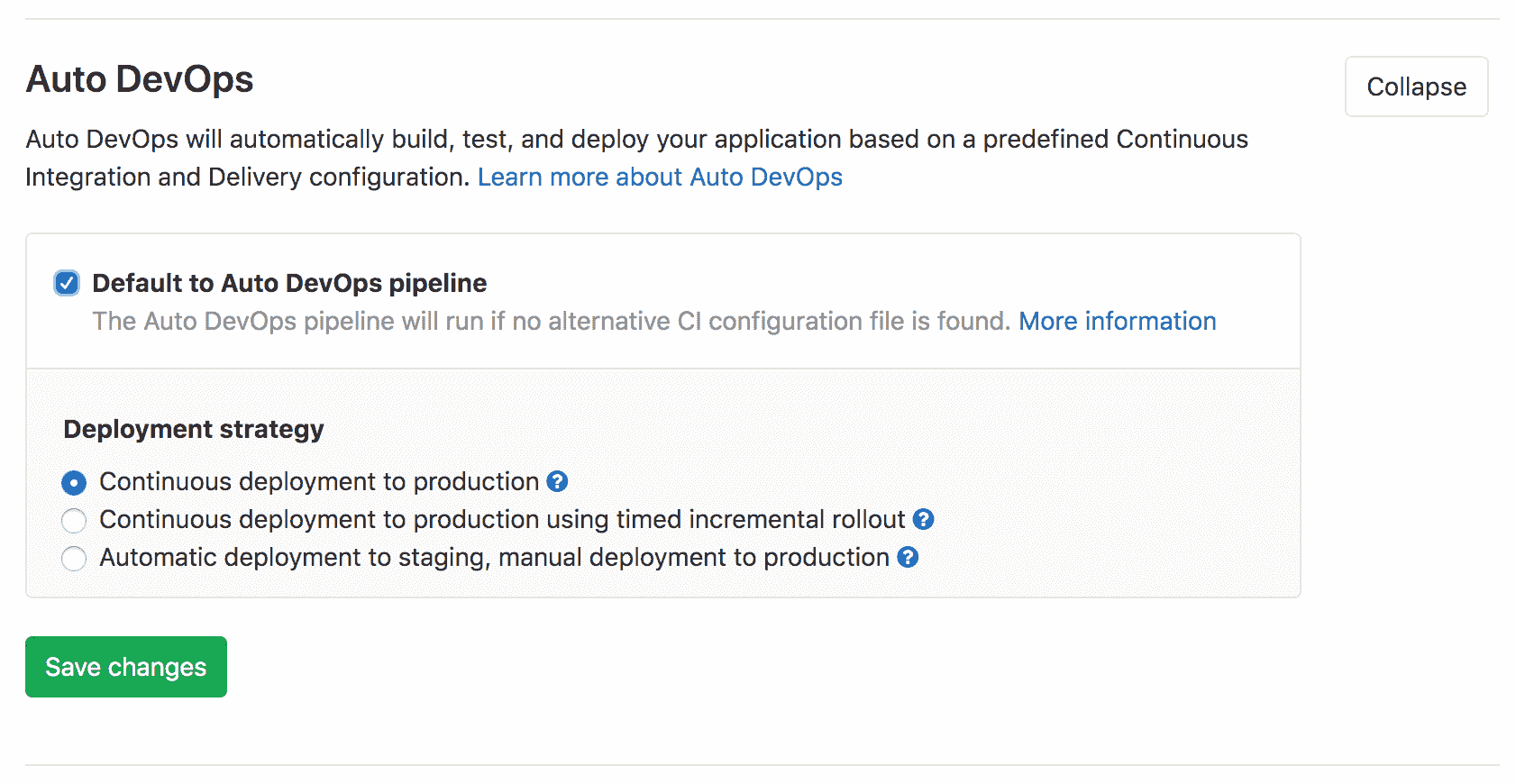](img/guide_enable_autodevops_v12_3.png)
保存更改后,GitLab 將創建一個新管道. 要查看它,請轉到 **CI / CD>管道** .
在下一節中,我們將解釋管道中每個作業的作用.
## Deploy the application[](#deploy-the-application "Permalink")
當管道運行時,它在做什么?
要查看管道中的作業,請單擊管道的狀態標記. 的 圖標在管道作業運行時顯示,并在不刷新頁面的情況下進行更新 (成功)或 (失敗)作業完成時.
作業分為以下幾個階段:
[](img/guide_pipeline_stages_v13_0.png)
* **構建** -應用程序將構建 Docker 映像并將其上傳到項目的[Container Registry](../../user/packages/container_registry/index.html) ( [Auto Build](stages.html#auto-build) ).
* **測試** -GitLab 在應用程序上運行各種檢查:
* `test`作業通過檢測語言和框架來運行單元測試和集成測試( [自動測試](stages.html#auto-test) )
* `code_quality`作業檢查代碼質量,并允許失敗( [自動代碼質量](stages.html#auto-code-quality-starter) )
* `container_scanning`作業檢查 Docker 容器是否存在任何漏洞并被允許失敗( [自動容器掃描](stages.html#auto-container-scanning-ultimate) )
* `dependency_scanning`作業檢查應用程序是否具有易受漏洞影響的任何依賴關系,并允許其失敗( [自動依賴關系掃描](stages.html#auto-dependency-scanning-ultimate) )
* 后綴為`-sast`作業在當前代碼上運行靜態分析,以檢查潛在的安全問題,并允許其失敗( [Auto SAST](stages.html#auto-sast-ultimate) )
* `secret-detection`作業會檢查泄漏的機密并允許其失敗( [自動機密檢測](stages.html#auto-secret-detection-ultimate) )
* `license_management`作業搜索應用程序的依存關系,以確定其每個許可證并被允許失敗( [自動許可證合規](stages.html#auto-license-compliance-ultimate) )**注意:**除`test`外,所有作業均允許在測試階段失敗.
* **回顧** -對輸水管道`master`包括這個階段有`dast_environment_deploy`工作. 要了解更多信息,請參閱[動態應用程序安全性測試(DAST)](../../user/application_security/dast/index.html) .
* **生產** -測試和檢查完成后,該應用程序將在 Kubernetes 中進行部署( [Auto Deploy](stages.html#auto-deploy) ).
* **性能** -性能測試在已部署的應用程序上運行( [自動瀏覽器性能測試](stages.html#auto-browser-performance-testing-premium) ).
* **清理** -對輸水管道`master`包括這個階段有`stop_dast_environment`工作.
在運行管道之后,您應該查看已部署的網站并學習如何對其進行監視.
### Monitor your project[](#monitor-your-project "Permalink")
成功部署您的應用程序后,您可以通過導航到" **環境"**頁面來查看其網站并檢查其運行狀況. **運營>環境** . 該頁面顯示有關已部署應用程序的詳細信息,右側列顯示將您鏈接到常見環境任務的圖標:
[](img/guide_environments_v12_3.png)
* **開放的現場環境** ( )-打開生產環境中部署的應用程序的 URL
* **Monitoring** () - Opens the metrics page where Prometheus collects data about the Kubernetes cluster and how the application affects it in terms of memory usage, CPU usage, and latency
* **部署到** ( )-顯示可以部署到的環境的列表
* **終端** ( )-在運行應用程序的容器內打開[Web 終端](../../ci/environments/index.html#web-terminals)會話
* **重新部署到環境** ( )-有關更多信息,請參閱[重試和回滾](../../ci/environments/index.html#retrying-and-rolling-back)
* **停止環境** ( )-有關更多信息,請參閱[停止環境](../../ci/environments/index.html#stopping-an-environment)
GitLab 在環境信息下方顯示[部署板](../../user/project/deploy_boards.html) ,并用正方形表示 Kubernetes 集群中的 Pod,并用顏色編碼以顯示其狀態. 將鼠標懸停在部署板上的正方形上會顯示部署的狀態,單擊該正方形會將您帶到窗格的日志頁面.
**提示:**該示例目前僅顯示一個托管應用程序的 Pod,但是您可以通過在以下[`REPLICAS`](customize.html#environment-variables)定義[`REPLICAS`變量](customize.html#environment-variables)來添加更多 Pod **設置> CI / CD>環境變量** .
### Work with branches[](#work-with-branches "Permalink")
按照[GitLab 流程](../gitlab_flow.html#working-with-feature-branches) ,您接下來應該創建一個功能分支以向您的應用程序添加內容:
1. 在項目的存儲庫中,導航到以下文件: `app/views/welcome/index.html.erb` . 該文件應僅包含一個段落: `<p>You're on Rails!</p>` .
2. 打開 GitLab [Web IDE](../../user/project/web_ide/index.html)進行更改.
3. 編輯文件,使其包含:
```
<p>You're on Rails! Powered by GitLab Auto DevOps.</p>
```
4. 暫存文件. 添加提交消息,然后通過單擊**Commit**創建一個新分支和一個合并請求.
[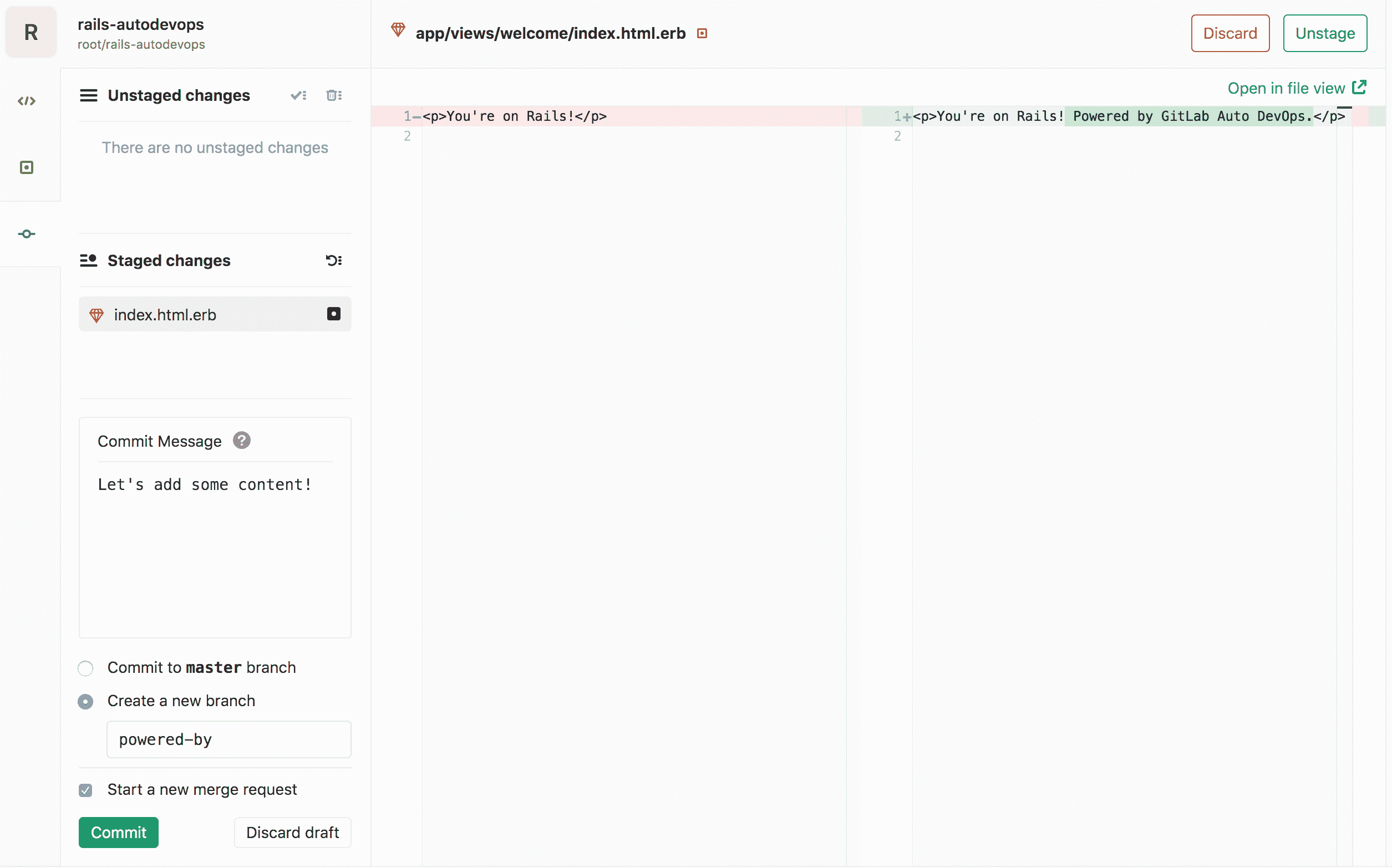](img/guide_ide_commit_v12_3.png)
提交合并請求后,GitLab 運行你的管道,而在這一切的工作,如[前文所述](#deploy-the-application) ,除了僅在比其他分支多跑幾個`master` .
[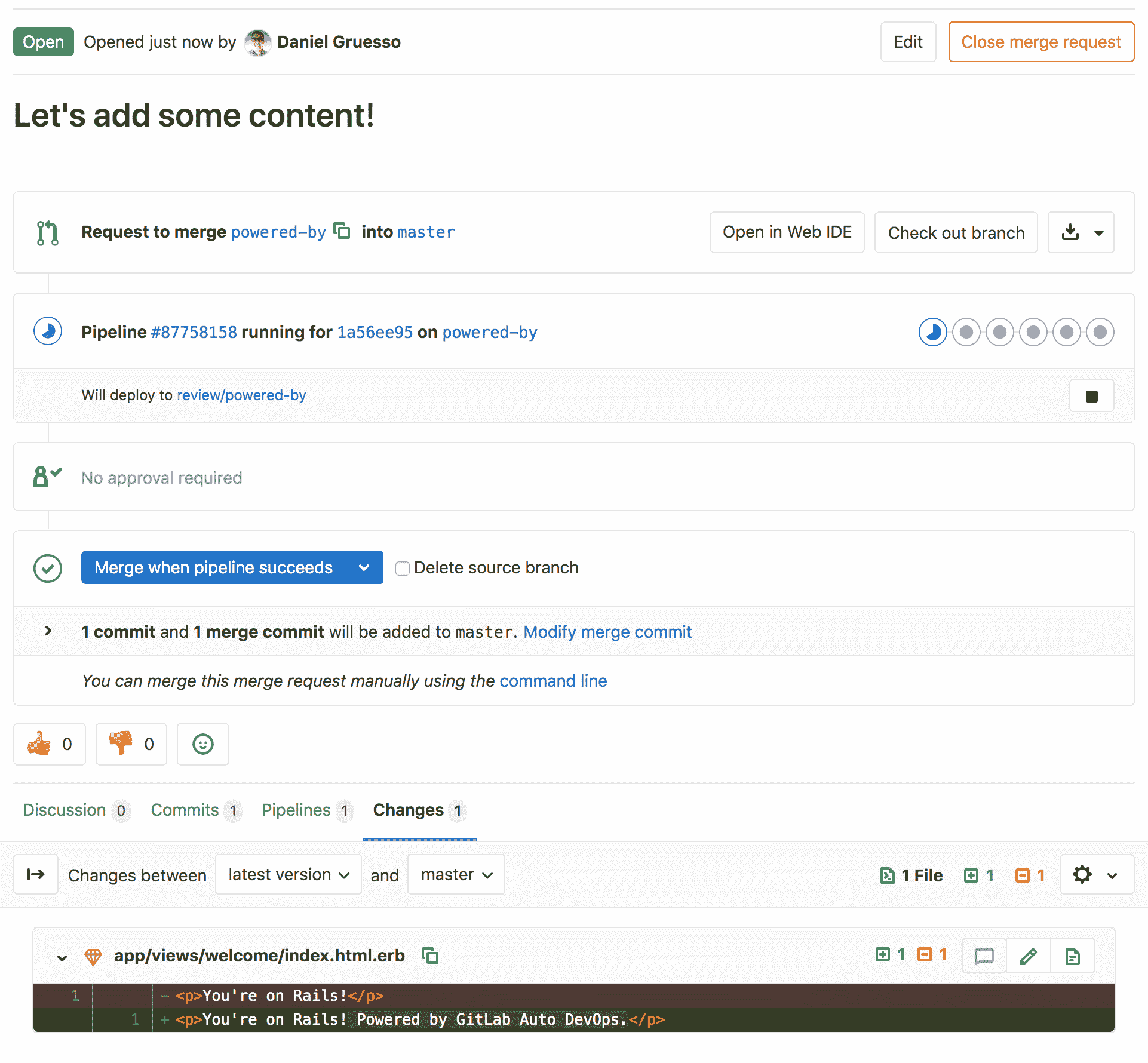](img/guide_merge_request_v12_3.png)
幾分鐘后,您會注意到測試失敗,這意味著您的更改"破壞了"測試. 單擊失敗的`test`作業以查看有關它的更多信息:
```
Failure:
WelcomeControllerTest#test_should_get_index [/app/test/controllers/welcome_controller_test.rb:7]:
<You're on Rails!> expected but was
<You're on Rails! Powered by GitLab Auto DevOps.>..
Expected 0 to be >= 1.
bin/rails test test/controllers/welcome_controller_test.rb:4
```
要修復損壞的測試:
1. 返回到合并請求的" **概述"**頁面,然后單擊" **在 Web IDE 中打開"** .
2. 在文件的左側目錄中,找到`test/controllers/welcome_controller_test.rb`文件,然后單擊將其打開.
3. 更改第 7 行,說" `You're on Rails! Powered by GitLab Auto DevOps.` `You're on Rails! Powered by GitLab Auto DevOps.`
4. Click **Commit**.
5. 在左側列的"未**分段的更改"下** ,單擊選中標記圖標( )進行更改.
6. 編寫提交消息,然后單擊**提交** .
返回到合并請求的" **概述"**頁面,您不僅應該看到測試通過,而且應該看到部署為[審閱應用程序的應用程序](stages.html#auto-review-apps) . 您可以通過單擊**查看應用程序**來訪問它 按鈕以查看已部署的更改.
[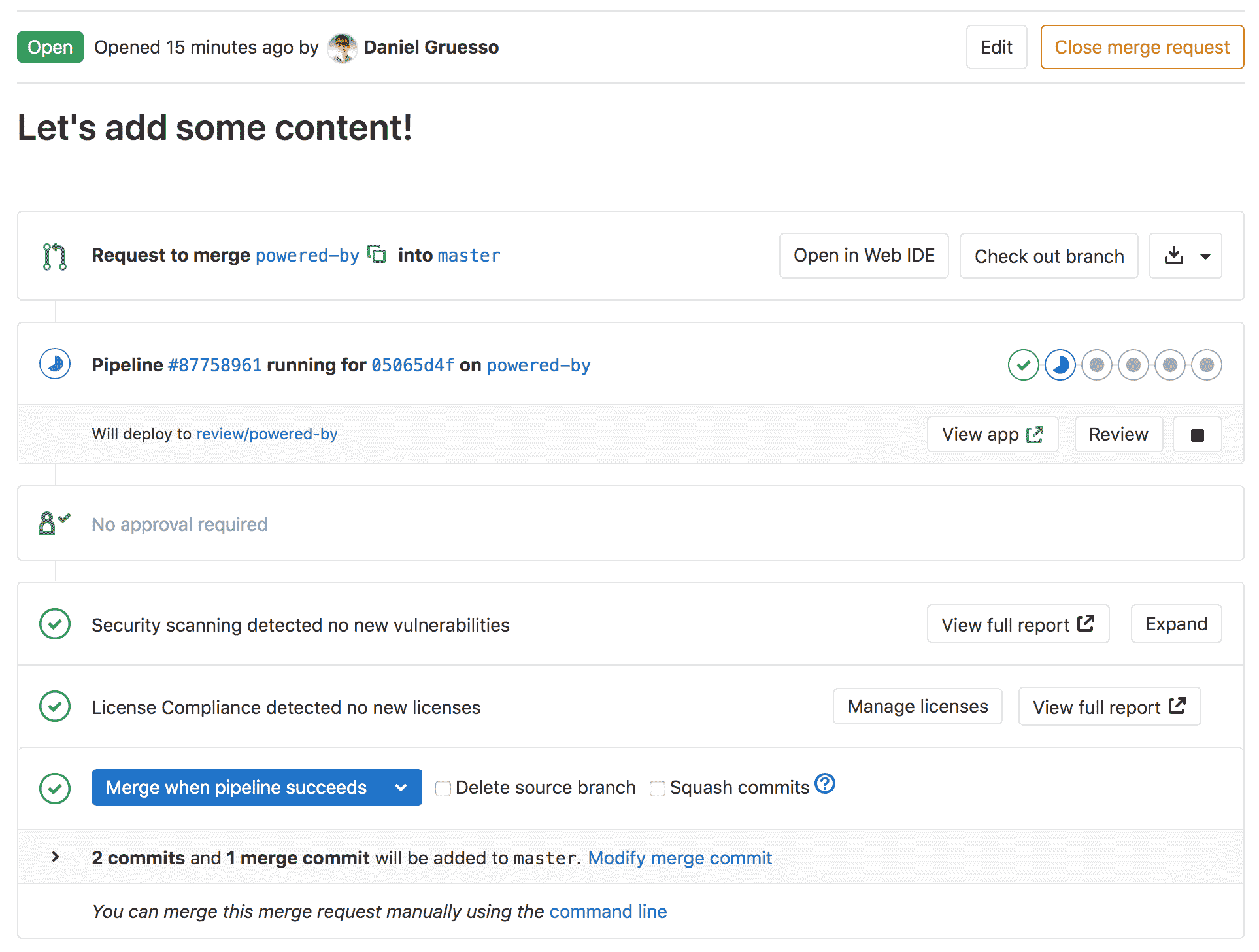](img/guide_merge_request_review_app_v12_3.png)
合并合并請求后,GitLab 在`master`分支上運行管道,然后將應用程序部署到生產環境.
## Conclusion[](#conclusion "Permalink")
實施該項目之后,您應該對 Auto DevOps 的基礎有深入的了解. 您從構建和測試開始,到在 GitLab 中全部部署和監視應用程序. 盡管具有自動特性,但也可以配置和自定義 Auto DevOps 以適合您的工作流程. 以下是一些有用的資源,供您進一步閱讀:
1. [Auto DevOps](index.html)
2. [Multiple Kubernetes clusters](index.html#using-multiple-kubernetes-clusters)
3. [Incremental rollout to production](customize.html#incremental-rollout-to-production-premium)
4. [Disable jobs you don’t need with environment variables](customize.html#environment-variables)
5. [Use a static IP for your cluster](../../user/clusters/applications.html#using-a-static-ip)
6. [Use your own buildpacks to build your application](customize.html#custom-buildpacks)
7. [Prometheus monitoring](../../user/project/integrations/prometheus.html)
- GitLab Docs
- Installation
- Requirements
- GitLab cloud native Helm Chart
- Install GitLab with Docker
- Installation from source
- Install GitLab on Microsoft Azure
- Installing GitLab on Google Cloud Platform
- Installing GitLab on Amazon Web Services (AWS)
- Analytics
- Code Review Analytics
- Productivity Analytics
- Value Stream Analytics
- Kubernetes clusters
- Adding and removing Kubernetes clusters
- Adding EKS clusters
- Adding GKE clusters
- Group-level Kubernetes clusters
- Instance-level Kubernetes clusters
- Canary Deployments
- Cluster Environments
- Deploy Boards
- GitLab Managed Apps
- Crossplane configuration
- Cluster management project (alpha)
- Kubernetes Logs
- Runbooks
- Serverless
- Deploying AWS Lambda function using GitLab CI/CD
- Securing your deployed applications
- Groups
- Contribution Analytics
- Custom group-level project templates
- Epics
- Manage epics
- Group Import/Export
- Insights
- Issues Analytics
- Iterations
- Public access
- SAML SSO for GitLab.com groups
- SCIM provisioning using SAML SSO for GitLab.com groups
- Subgroups
- Roadmap
- Projects
- GitLab Secure
- Security Configuration
- Container Scanning
- Dependency Scanning
- Dependency List
- Static Application Security Testing (SAST)
- Secret Detection
- Dynamic Application Security Testing (DAST)
- GitLab Security Dashboard
- Offline environments
- Standalone Vulnerability pages
- Security scanner integration
- Badges
- Bulk editing issues and merge requests at the project level
- Code Owners
- Compliance
- License Compliance
- Compliance Dashboard
- Create a project
- Description templates
- Deploy Keys
- Deploy Tokens
- File finder
- Project integrations
- Integrations
- Atlassian Bamboo CI Service
- Bugzilla Service
- Custom Issue Tracker service
- Discord Notifications service
- Enabling emails on push
- GitHub project integration
- Hangouts Chat service
- Atlassian HipChat
- Irker IRC Gateway
- GitLab Jira integration
- Mattermost Notifications Service
- Mattermost slash commands
- Microsoft Teams service
- Mock CI Service
- Prometheus integration
- Redmine Service
- Slack Notifications Service
- Slack slash commands
- GitLab Slack application
- Webhooks
- YouTrack Service
- Insights
- Issues
- Crosslinking Issues
- Design Management
- Confidential issues
- Due dates
- Issue Boards
- Issue Data and Actions
- Labels
- Managing issues
- Milestones
- Multiple Assignees for Issues
- Related issues
- Service Desk
- Sorting and ordering issue lists
- Issue weight
- Associate a Zoom meeting with an issue
- Merge requests
- Allow collaboration on merge requests across forks
- Merge Request Approvals
- Browser Performance Testing
- How to create a merge request
- Cherry-pick changes
- Code Quality
- Load Performance Testing
- Merge Request dependencies
- Fast-forward merge requests
- Merge when pipeline succeeds
- Merge request conflict resolution
- Reverting changes
- Reviewing and managing merge requests
- Squash and merge
- Merge requests versions
- Draft merge requests
- Members of a project
- Migrating projects to a GitLab instance
- Import your project from Bitbucket Cloud to GitLab
- Import your project from Bitbucket Server to GitLab
- Migrating from ClearCase
- Migrating from CVS
- Import your project from FogBugz to GitLab
- Gemnasium
- Import your project from GitHub to GitLab
- Project importing from GitLab.com to your private GitLab instance
- Import your project from Gitea to GitLab
- Import your Jira project issues to GitLab
- Migrating from Perforce Helix
- Import Phabricator tasks into a GitLab project
- Import multiple repositories by uploading a manifest file
- Import project from repo by URL
- Migrating from SVN to GitLab
- Migrating from TFVC to Git
- Push Options
- Releases
- Repository
- Branches
- Git Attributes
- File Locking
- Git file blame
- Git file history
- Repository mirroring
- Protected branches
- Protected tags
- Push Rules
- Reduce repository size
- Signing commits with GPG
- Syntax Highlighting
- GitLab Web Editor
- Web IDE
- Requirements Management
- Project settings
- Project import/export
- Project access tokens (Alpha)
- Share Projects with other Groups
- Snippets
- Static Site Editor
- Wiki
- Project operations
- Monitor metrics for your CI/CD environment
- Set up alerts for Prometheus metrics
- Embedding metric charts within GitLab-flavored Markdown
- Embedding Grafana charts
- Using the Metrics Dashboard
- Dashboard YAML properties
- Metrics dashboard settings
- Panel types for dashboards
- Using Variables
- Templating variables for metrics dashboards
- Prometheus Metrics library
- Monitoring AWS Resources
- Monitoring HAProxy
- Monitoring Kubernetes
- Monitoring NGINX
- Monitoring NGINX Ingress Controller
- Monitoring NGINX Ingress Controller with VTS metrics
- Alert Management
- Error Tracking
- Tracing
- Incident Management
- GitLab Status Page
- Feature Flags
- GitLab CI/CD
- GitLab CI/CD pipeline configuration reference
- GitLab CI/CD include examples
- Introduction to CI/CD with GitLab
- Getting started with GitLab CI/CD
- How to enable or disable GitLab CI/CD
- Using SSH keys with GitLab CI/CD
- Migrating from CircleCI
- Migrating from Jenkins
- Auto DevOps
- Getting started with Auto DevOps
- Requirements for Auto DevOps
- Customizing Auto DevOps
- Stages of Auto DevOps
- Upgrading PostgreSQL for Auto DevOps
- Cache dependencies in GitLab CI/CD
- GitLab ChatOps
- Cloud deployment
- Docker integration
- Building Docker images with GitLab CI/CD
- Using Docker images
- Building images with kaniko and GitLab CI/CD
- GitLab CI/CD environment variables
- Predefined environment variables reference
- Where variables can be used
- Deprecated GitLab CI/CD variables
- Environments and deployments
- Protected Environments
- GitLab CI/CD Examples
- Test a Clojure application with GitLab CI/CD
- Using Dpl as deployment tool
- Testing a Phoenix application with GitLab CI/CD
- End-to-end testing with GitLab CI/CD and WebdriverIO
- DevOps and Game Dev with GitLab CI/CD
- Deploy a Spring Boot application to Cloud Foundry with GitLab CI/CD
- How to deploy Maven projects to Artifactory with GitLab CI/CD
- Testing PHP projects
- Running Composer and NPM scripts with deployment via SCP in GitLab CI/CD
- Test and deploy Laravel applications with GitLab CI/CD and Envoy
- Test and deploy a Python application with GitLab CI/CD
- Test and deploy a Ruby application with GitLab CI/CD
- Test and deploy a Scala application to Heroku
- GitLab CI/CD for external repositories
- Using GitLab CI/CD with a Bitbucket Cloud repository
- Using GitLab CI/CD with a GitHub repository
- GitLab Pages
- GitLab Pages
- GitLab Pages domain names, URLs, and baseurls
- Create a GitLab Pages website from scratch
- Custom domains and SSL/TLS Certificates
- GitLab Pages integration with Let's Encrypt
- GitLab Pages Access Control
- Exploring GitLab Pages
- Incremental Rollouts with GitLab CI/CD
- Interactive Web Terminals
- Optimizing GitLab for large repositories
- Metrics Reports
- CI/CD pipelines
- Pipeline Architecture
- Directed Acyclic Graph
- Multi-project pipelines
- Parent-child pipelines
- Pipelines for Merge Requests
- Pipelines for Merged Results
- Merge Trains
- Job artifacts
- Pipeline schedules
- Pipeline settings
- Triggering pipelines through the API
- Review Apps
- Configuring GitLab Runners
- GitLab CI services examples
- Using MySQL
- Using PostgreSQL
- Using Redis
- Troubleshooting CI/CD
- GitLab Package Registry
- GitLab Container Registry
- Dependency Proxy
- GitLab Composer Repository
- GitLab Conan Repository
- GitLab Maven Repository
- GitLab NPM Registry
- GitLab NuGet Repository
- GitLab PyPi Repository
- API Docs
- API resources
- .gitignore API
- GitLab CI YMLs API
- Group and project access requests API
- Appearance API
- Applications API
- Audit Events API
- Avatar API
- Award Emoji API
- Project badges API
- Group badges API
- Branches API
- Broadcast Messages API
- Project clusters API
- Group clusters API
- Instance clusters API
- Commits API
- Container Registry API
- Custom Attributes API
- Dashboard annotations API
- Dependencies API
- Deploy Keys API
- Deployments API
- Discussions API
- Dockerfiles API
- Environments API
- Epics API
- Events
- Feature Flags API
- Feature flag user lists API
- Freeze Periods API
- Geo Nodes API
- Group Activity Analytics API
- Groups API
- Import API
- Issue Boards API
- Group Issue Boards API
- Issues API
- Epic Issues API
- Issues Statistics API
- Jobs API
- Keys API
- Labels API
- Group Labels API
- License
- Licenses API
- Issue links API
- Epic Links API
- Managed Licenses API
- Markdown API
- Group and project members API
- Merge request approvals API
- Merge requests API
- Project milestones API
- Group milestones API
- Namespaces API
- Notes API
- Notification settings API
- Packages API
- Pages domains API
- Pipeline schedules API
- Pipeline triggers API
- Pipelines API
- Project Aliases API
- Project import/export API
- Project repository storage moves API
- Project statistics API
- Project templates API
- Projects API
- Protected branches API
- Protected tags API
- Releases API
- Release links API
- Repositories API
- Repository files API
- Repository submodules API
- Resource label events API
- Resource milestone events API
- Resource weight events API
- Runners API
- SCIM API
- Search API
- Services API
- Application settings API
- Sidekiq Metrics API
- Snippets API
- Project snippets
- Application statistics API
- Suggest Changes API
- System hooks API
- Tags API
- Todos API
- Users API
- Project-level Variables API
- Group-level Variables API
- Version API
- Vulnerabilities API
- Vulnerability Findings API
- Wikis API
- GraphQL API
- Getting started with GitLab GraphQL API
- GraphQL API Resources
- API V3 to API V4
- Validate the .gitlab-ci.yml (API)
- User Docs
- Abuse reports
- User account
- Active sessions
- Deleting a User account
- Permissions
- Personal access tokens
- Profile preferences
- Threads
- GitLab and SSH keys
- GitLab integrations
- Git
- GitLab.com settings
- Infrastructure as code with Terraform and GitLab
- GitLab keyboard shortcuts
- GitLab Markdown
- AsciiDoc
- GitLab Notification Emails
- GitLab Quick Actions
- Autocomplete characters
- Reserved project and group names
- Search through GitLab
- Advanced Global Search
- Advanced Syntax Search
- Time Tracking
- GitLab To-Do List
- Administrator Docs
- Reference architectures
- Reference architecture: up to 1,000 users
- Reference architecture: up to 2,000 users
- Reference architecture: up to 3,000 users
- Reference architecture: up to 5,000 users
- Reference architecture: up to 10,000 users
- Reference architecture: up to 25,000 users
- Reference architecture: up to 50,000 users
- Troubleshooting a reference architecture set up
- Working with the bundled Consul service
- Configuring PostgreSQL for scaling
- Configuring GitLab application (Rails)
- Load Balancer for multi-node GitLab
- Configuring a Monitoring node for Scaling and High Availability
- NFS
- Working with the bundled PgBouncer service
- Configuring Redis for scaling
- Configuring Sidekiq
- Admin Area settings
- Continuous Integration and Deployment Admin settings
- Custom instance-level project templates
- Diff limits administration
- Enable and disable GitLab features deployed behind feature flags
- Geo nodes Admin Area
- GitLab Pages administration
- Health Check
- Job logs
- Labels administration
- Log system
- PlantUML & GitLab
- Repository checks
- Repository storage paths
- Repository storage types
- Account and limit settings
- Service templates
- System hooks
- Changing your time zone
- Uploads administration
- Abuse reports
- Activating and deactivating users
- Audit Events
- Blocking and unblocking users
- Broadcast Messages
- Elasticsearch integration
- Gitaly
- Gitaly Cluster
- Gitaly reference
- Monitoring GitLab
- Monitoring GitLab with Prometheus
- Performance Bar
- Usage statistics
- Object Storage
- Performing Operations in GitLab
- Cleaning up stale Redis sessions
- Fast lookup of authorized SSH keys in the database
- Filesystem Performance Benchmarking
- Moving repositories managed by GitLab
- Run multiple Sidekiq processes
- Sidekiq MemoryKiller
- Switching to Puma
- Understanding Unicorn and unicorn-worker-killer
- User lookup via OpenSSH's AuthorizedPrincipalsCommand
- GitLab Package Registry administration
- GitLab Container Registry administration
- Replication (Geo)
- Geo database replication
- Geo with external PostgreSQL instances
- Geo configuration
- Using a Geo Server
- Updating the Geo nodes
- Geo with Object storage
- Docker Registry for a secondary node
- Geo for multiple nodes
- Geo security review (Q&A)
- Location-aware Git remote URL with AWS Route53
- Tuning Geo
- Removing secondary Geo nodes
- Geo data types support
- Geo Frequently Asked Questions
- Geo Troubleshooting
- Geo validation tests
- Disaster Recovery (Geo)
- Disaster recovery for planned failover
- Bring a demoted primary node back online
- Automatic background verification
- Rake tasks
- Back up and restore GitLab
- Clean up
- Namespaces
- Maintenance Rake tasks
- Geo Rake Tasks
- GitHub import
- Import bare repositories
- Integrity check Rake task
- LDAP Rake tasks
- Listing repository directories
- Praefect Rake tasks
- Project import/export administration
- Repository storage Rake tasks
- Generate sample Prometheus data
- Uploads migrate Rake tasks
- Uploads sanitize Rake tasks
- User management
- Webhooks administration
- X.509 signatures
- Server hooks
- Static objects external storage
- Updating GitLab
- GitLab release and maintenance policy
- Security
- Password Storage
- Custom password length limits
- Restrict allowed SSH key technologies and minimum length
- Rate limits
- Webhooks and insecure internal web services
- Information exclusivity
- How to reset your root password
- How to unlock a locked user from the command line
- User File Uploads
- How we manage the TLS protocol CRIME vulnerability
- User email confirmation at sign-up
- Security of running jobs
- Proxying assets
- CI/CD Environment Variables
- Contributor and Development Docs
- Contribute to GitLab
- Community members & roles
- Implement design & UI elements
- Issues workflow
- Merge requests workflow
- Code Review Guidelines
- Style guides
- GitLab Architecture Overview
- CI/CD development documentation
- Database guides
- Database Review Guidelines
- Database Review Guidelines
- Migration Style Guide
- What requires downtime?
- Understanding EXPLAIN plans
- Rake tasks for developers
- Mass inserting Rails models
- GitLab Documentation guidelines
- Documentation Style Guide
- Documentation structure and template
- Documentation process
- Documentation site architecture
- Global navigation
- GitLab Docs monthly release process
- Telemetry Guide
- Usage Ping Guide
- Snowplow Guide
- Experiment Guide
- Feature flags in development of GitLab
- Feature flags process
- Developing with feature flags
- Feature flag controls
- Document features deployed behind feature flags
- Frontend Development Guidelines
- Accessibility & Readability
- Ajax
- Architecture
- Axios
- Design Patterns
- Frontend Development Process
- DropLab
- Emojis
- Filter
- Frontend FAQ
- GraphQL
- Icons and SVG Illustrations
- InputSetter
- Performance
- Principles
- Security
- Tooling
- Vuex
- Vue
- Geo (development)
- Geo self-service framework (alpha)
- Gitaly developers guide
- GitLab development style guides
- API style guide
- Go standards and style guidelines
- GraphQL API style guide
- Guidelines for shell commands in the GitLab codebase
- HTML style guide
- JavaScript style guide
- Migration Style Guide
- Newlines style guide
- Python Development Guidelines
- SCSS style guide
- Shell scripting standards and style guidelines
- Sidekiq debugging
- Sidekiq Style Guide
- SQL Query Guidelines
- Vue.js style guide
- Instrumenting Ruby code
- Testing standards and style guidelines
- Flaky tests
- Frontend testing standards and style guidelines
- GitLab tests in the Continuous Integration (CI) context
- Review Apps
- Smoke Tests
- Testing best practices
- Testing levels
- Testing Rails migrations at GitLab
- Testing Rake tasks
- End-to-end Testing
- Beginner's guide to writing end-to-end tests
- End-to-end testing Best Practices
- Dynamic Element Validation
- Flows in GitLab QA
- Page objects in GitLab QA
- Resource class in GitLab QA
- Style guide for writing end-to-end tests
- Testing with feature flags
- Translate GitLab to your language
- Internationalization for GitLab
- Translating GitLab
- Proofread Translations
- Merging translations from CrowdIn
- Value Stream Analytics development guide
- GitLab subscription
- Activate GitLab EE with a license
